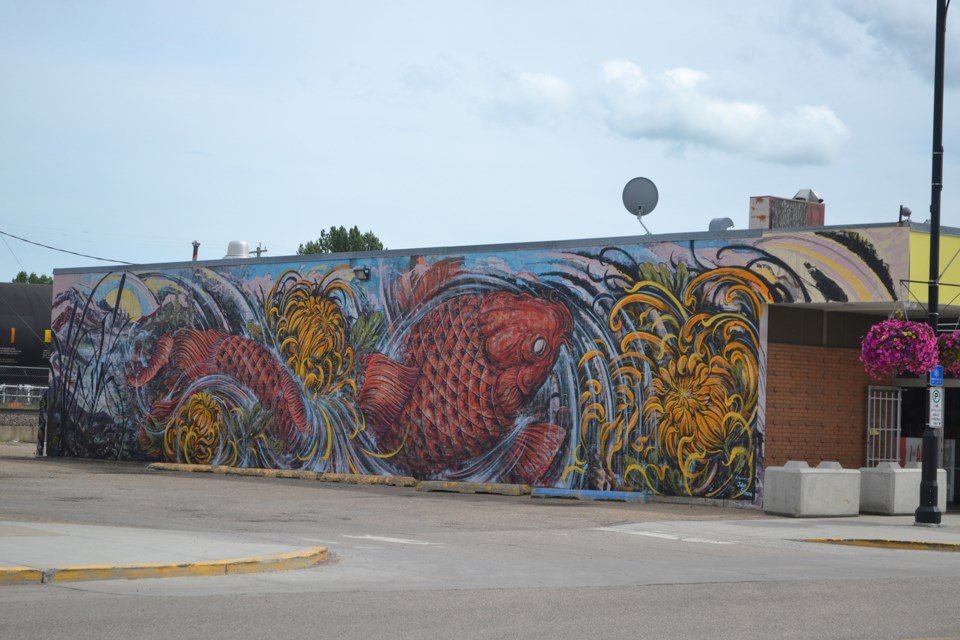OLDS — Rules for creating and hosting murals or street art are expected to come back to council for another look later this year after council members discussed them during their recent policies and priorities meeting.
The rules are contained in a proposed amended land use bylaw which council discussed at length, including time spent by Parkland Community Planning Services director Craig Teal to present them.
Under the rules, murals would be allowed in commercial, industrial and recreational districts but not on homes in residential districts.
Initial wording of the amended bylaw said “no mural shall contain full or partial human nudity; obscene or offensive language, symbols or messages; hateful language, symbols or messages, racist or exclusionary imagery or messages; political viewpoints or content; religious viewpoints or content; graffiti or street art; or any content that is or has the potential to cause divisiveness in the community.”
In the end, council members gave thumbs up to the bylaw in general, removing the nudity provision and the graffiti or street art provision, calling on administrative staff to bring back a revised bylaw to council in the future for more consideration.
Coun. Mary Anne pointed out some great art around the world contains nudity and that “beauty is in the eye of the beholder.” Deputy mayor Heather Ryan gave Michelangelo’s statue of David as an example.
In regard to graffiti or street art, community services director Doug Wagstaff pointed out the bylaw already governs graffiti and street art. Graffiti is defined as artwork that disfigures or defaces property.
“The crux of that is, do you have permission and if you don’t have permission, then it’s graffiti. If you do have permission, it needs to go through this process we’re talking about today,” he said.
In the bylaw, a mural is defined as “a picture, scene, graphic or diagram displayed on the exterior wall or surface of a building for the primary purpose of decoration or artistic expression and not created to solely display a commercial message or depiction.”
"We’re on the exterior of a building, we’re in a public space,” Teal said. “It’s not whether or not you’re allowed to have a nice fresco in your living room or an interior space, it’s very much about the exterior of a building in terms of land use bylaw regulation.”
Teal stressed that under the bylaw, murals are meant to be artistic, decorative works not “commercial messaging.” They can depict the town’s history or heritage, but don’t have to.
“The common theme is if it runs the risk of essentially offending or creating divisiveness within the community, it probably shouldn’t be a mural available for public viewing,” he said.
The plan calls for those wishing to create or host murals to apply to the town.
A development officer would examine the application, then send it to the town’s newly-created Public Art Advisory Committee (PAAC) for input. That committee includes town councillors as well as well-known local artists.
Because murals are categorized as a discretionary use, the application would go to the Municipal Planning Commission (MPC) for final approval or rejection.
“Discretionary use also means that it’s not an automatic approval if it meets all the requirements. Content still matters,” Teal said.
“So the planning and development authority could still say, ‘you’ve met all the requirements, but we just don’t think it’s appropriate on this particular site.’”
After the PAAC has provided written permission for the mural to be created, the municipality has 30 days to process the application. After that, if no decision is made, the applicant can file an appeal.
Teal said if later on, the mural appears to be faded and worn, "it's up to the owner and whatever arrangements they’ve made with the original artists or the original group that commissioned it to do a touch-up or maintain the mural in that respect.”
That includes making sure that if it’s not painted right on the building, arrangements are made to ensure it remains safely and securely attached to the building.
Chief administrative officer Michael Merritt said bylaw officers will watch for those issues.
When the matter came up for questions and answers, councillors Wanda Blatz and Mary Anne Overwater said they were under the impression council members would also be able to weigh in on the suitability of proposed murals.
However, as discussion went on, council in general seemed to be OK with mural content and suitability examined by the PAAC with the Municipal Planning Commission giving the final approval or disapproval.
Overwater eventually said she liked the fact that the PAAC contains artists as well as councillors and that the MPC contains councillors and members at large, so she’s satisfied the process will include community input.
“To a certain degree it takes the onus off of council being the only ones who approve that art,” she said.
Blatz worried about how much time the approval process could take.
"I think then we need to make sure that it’s not going to be drawn out for four or five months, because we only have a window of opportunity to be painting in our country and you know, that’s a few months in the summertime that’s ideal,” she said.
Coun. Mitch Thomson worried that the whole process might be too “bureaucratic.”
Community services director Doug Wagstaff said the decision to have the approval process take some time was “intentional” so someone wouldn’t be able to “paint something on a whim and it goes up.”



